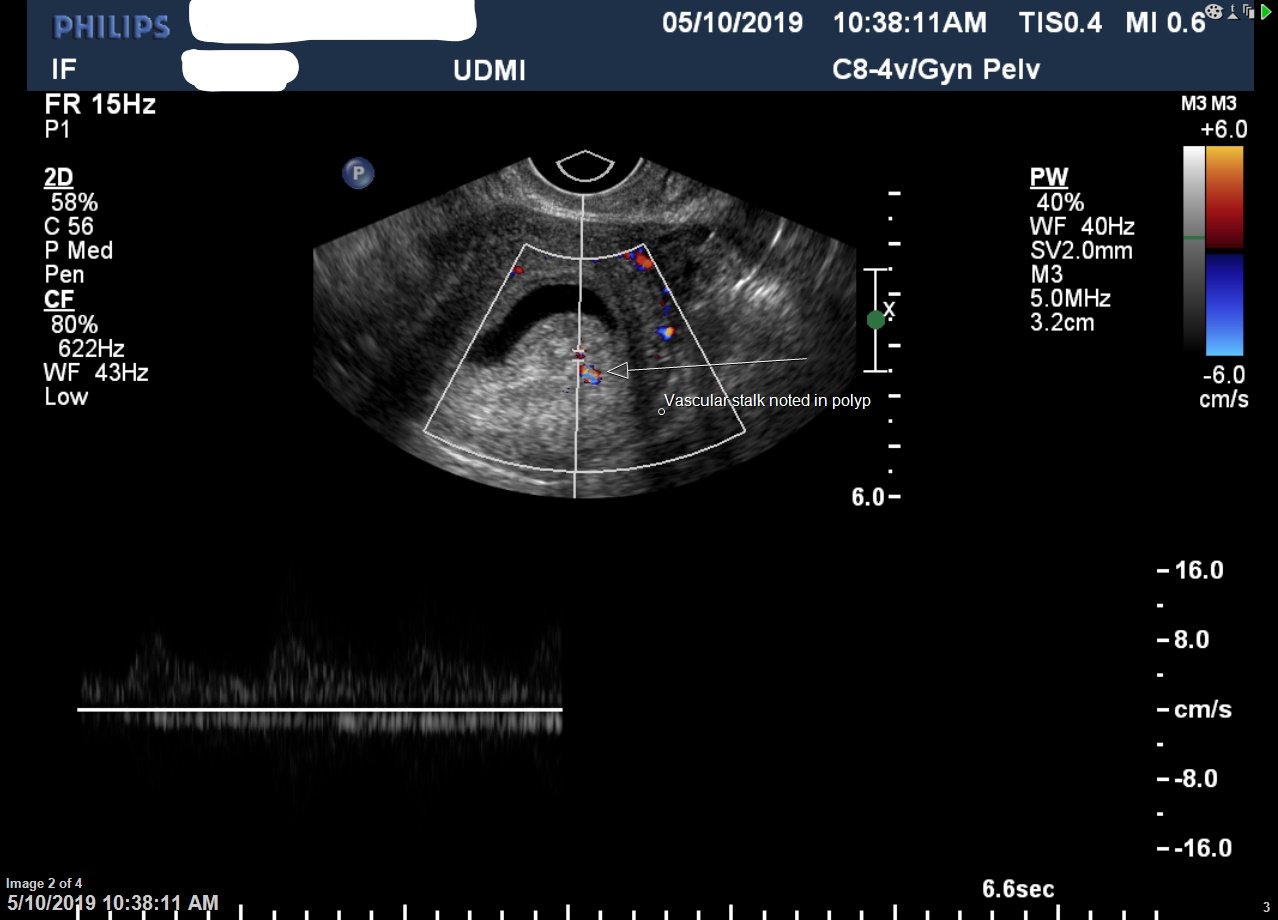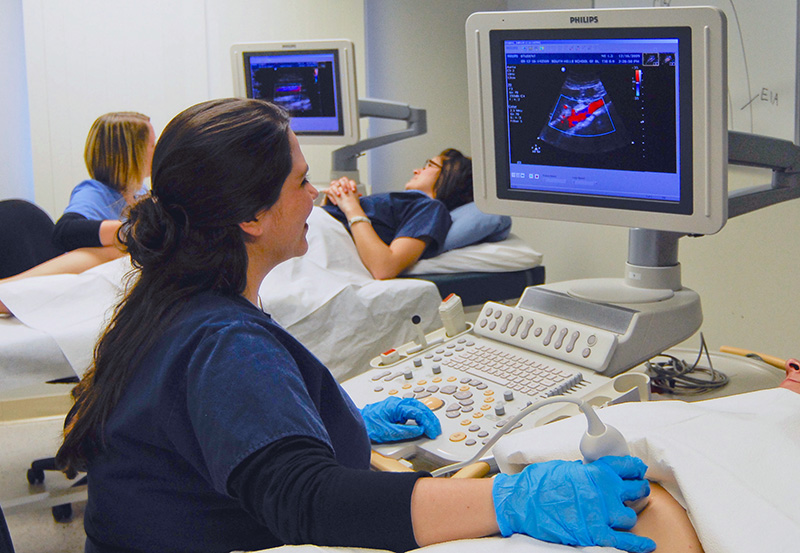Sonography (ultrasonography) is widely used in medicine. It is possible to perform both diagnosis and therapeutic procedures, using ultrasound to guide interventional procedures which can be both diagnostic and therapeutic. Sonography is widely employed in obstetrics and gynecology, with approximately 10.1% of the ultrasound examinations performed in the first trimester of pregnancy, 57.0% in the second trimester, and 32.9% in the third trimester.
What is a pelvic ultrasound with hysterosonogram?
Ultrasound imaging uses sound waves to create pictures of the inside of the body. A handheld device called a transducer (also called a probe or wand) sends and receives these soundwaves.
An Ultrasound of the pelvis is typically used to look at the bladder, ovaries, uterus, cervix, and fallopian tubes (some of these are known as the female reproductive organs). An ultrasound hysterosonogram fills the uterus with water to better evaluate the lining of the uterine cavity. The uterus is the hollow organ in the pelvis where a baby develops and grows.
There are two ways to create the pictures, through the abdomen (stomach) or through the vagina. If the transducer is moved over the abdomen it is known as a transabdominal pelvic ultrasound.
If the transducer is placed inside the vagina, then it is known as a transvaginal pelvic ultrasound. Transvaginal ultrasound takes a clearer picture than transabdominal ultrasound because the probe is closer to the organs being viewed (especially the uterus and ovaries). This exam includes both the transabdominal and transvaginal portions in order to completely assess the entire pelvic region.
Who is a Sonographer: a clinician who specializes in ultrasound technology.
Who is a Radiologist: doctor with special training in creating and interpreting pictures of the inside of the body.
How should I prepare?
The preparation for a pelvic ultrasound with Hysterosonogram is a full bladder.
The preparation for a pelvic ultrasound with Hysterosonogram is a full bladder. You will be asked to drink 24-32 ounces of liquid 1 hour before your appointment time. It takes 1 hour for this liquid to filter through your kidneys and reach your bladder. The full bladder provides a “window” to view the female organs on the transabdominal ultrasound. Without a full bladder, the view is limited. providers may ask you to empty your bladder for the transvaginal ultrasound (usually done after the transabdominal exam).
You should wear comfortable, loose-fitting clothing for your ultrasound exam. You may need to remove all clothing and jewelry in the area to be examined. You may be asked to wear a gown during the procedure.
It is best to perform the procedure one week after menstruation to avoid the risk of infection. At this time in the menstrual cycle, the endometrium is at its thinnest, which is the best time to determine if the endometrium is normal. The timing of the exam may vary, however, depending on the symptoms and their suspected origins. This procedure should not be performed if you are pregnant.
No special preparation is required prior to the exam. You may be advised to take an over-the-counter medication shortly before the procedure to minimize any potential discomfort.
What happens during the exam?
- The sonographer will ask several questions about your medical history related to female organs like procedures and surgeries, pregnancies, menstrual cycle dates, symptoms, and medications. The interpreting radiologist will use this information for interpreting the ultrasound image.
- You will lie on your back on a padded table. For part one (transabdominal exam) your bottom clothing will need to be lowered to just above the pubic area and a cloth will be used to protect the edge. The sonographer applies a warm gel to your skin to help the transducer make good contact and to improve the quality of the images. You can see a picture of the organs and blood vessels on a video screen. During this transabdominal ultrasound, you will likely feel bladder pressure and an urge to urinate because your bladder is full. This first part of the exam only takes a few minutes.
- After the transabdominal portion, you will be instructed to use the restroom and provide a urine sample for a pregnancy test to make sure that you are not pregnant. You may not need to provide a sample if you have been postmenopausal for one year. Your bladder must be completely emptied before part two, the transvaginal ultrasound.
- The providers will give you privacy to remove your clothing from the waist down and provide a sheet as a cover. Your hips will be elevated using a foam wedge or a stack of sheets. This allows space for the transducer handle to be angled while taking pictures.
- Maintaining as much coverage and privacy as possible, the sonographer will ask you to gently insert the end of the transvaginal transducer into the vagina in the same manner as a tampon. There will be cold lubricant jelly on the lower part of the transducer for comfort and to improve the image quality. If you prefer, you can ask the sonographer to insert the transvaginal probe by request. You will feel light to moderate pressure as the tip is positioned against the cervix. The transducer is moved up and down, side to side in small to wide movements to gain a view of the entire pelvis. Depending on the location of your pelvic organs, the sonographer may also need to apply varying degrees of pressure in order to create clear pictures. Some women may experience greater discomfort if they are already having pelvic pain.
- After checking the images, the radiologist will come into the room to perform the Hysterosonogram. The radiologist will go over the steps for the procedure and answer any questions that you may have before proceeding.
- For this portion of the test, stirrups will be needed. You will be asked to lie back with your feet in the stirrups at the end of the table. The radiologist may perform a pelvic exam in order to locate your cervix.
- The radiologist first inserts a plastic speculum in the vagina similar to a standard pelvic exam. The radiologist finds the uterine cervix and cleans it with iodine or another cleansing solution. Let your team know if you have an allergy to iodine.
- Following this cleaning, the radiologist inserts a thin catheter into the cervix in order to put sterile water into the uterus. This can take a few minutes to position the catheter properly as this tube is very flexible.
- The radiologist then removes the speculum and inserts the ultrasound transducer again into the vagina next to the catheter. The sonographer will take a series of images for the radiologist to review while the radiologist is slowly putting sterile water inside of the uterine cavity. The water infusion will often cause pelvic cramps. Every patient experiences varying degrees of cramping which can range from mild to more intense. This portion of the exams takes less than 5 minutes to perform, and the cramps usually resolve once the water infusion is stopped and the catheter is removed. You may notice blood tinted secretions after the exam which is normal. They will provide you with a pad after the exam.
What are the benefits and risks?
Pelvic ultrasound with Hysterosonogram is used to make medical decisions about your current condition or symptoms. There are no common risks from this ultrasound. If you have any concerns after your exam, you may call your provider.
Who will give me my ultrasound results?
The radiologist will evaluate your pictures after obtaining the images and send a report to your provider. You will receive your ultrasound results from your ordering provider.
How is the transducer cleaned?
The Transvaginal ultrasound transducer is cleaned and disinfected after every use following High-Level disinfecting methods. Before vaginal insertion, the transducer is covered with a latex (or non-latex for allergies) sleeve.
Which types of results should I expect in fertility cases?
In most cases, the diagnoses obtained by hysterosonography showed normal uterine cavities. According to studies, the most common anomalous findings were polyps, followed by synechiae, submucous myoma, and Müllerian duct anomalies. Hysterosonography is a good option for evaluating the uterus and offers a high positive predictive value, while hysteroscopy stands as the gold standard.






